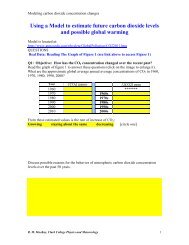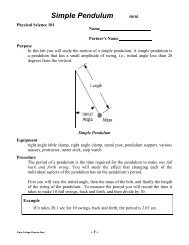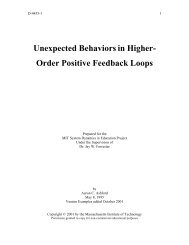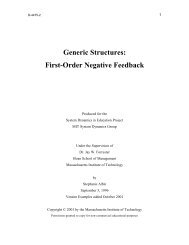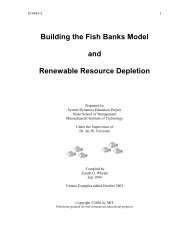ECONOMIC SUPPLY & DEMAND
ECONOMIC SUPPLY & DEMAND
ECONOMIC SUPPLY & DEMAND
Create successful ePaper yourself
Turn your PDF publications into a flip-book with our unique Google optimized e-Paper software.
32 D-43887. APPENDIX7.1 Model EquationsDemand Sectordemand = demand_price_schedule+step(10,10)DOCUMENT: This is the rate at which consumers wish to purchase clothing from thecompany. The step function is used to jar the system out of equilibrium.UNITS: shirts per weekdemand_price_schedule = GRAPH(price)(5.00, 100), (10.0, 73.0), (15.0, 57.0), (20.0, 45.0), (25.0, 35.0), (30.0, 28.0), (35.0, 22.0),(40.0, 18.0), (45.0, 14.0), (50.0, 10.0)DOCUMENT: This is based on the simple demand curve. At some particular price, theconsumers are willing and able to purchase clothing at a certain rate; the lower the price,the higher the demand.UNITS: shirts per weekPrice Sectorprice(t) = price(t - dt) + (change_in_price) * dtINIT price = 15DOCUMENT: Price is modeled as a stock in order to model the delays inherent inchanges in price.UNITS : dollars per shirtINFLOWS:change_in_price = ((desired_price)-price)/price_change_delayDOCUMENT: Change in price can be either positive or negative depending onthe effect_on_price. If the effect_on_price > 1, then price will increase. If theeffect_on_price < 1, then the price decreases. If effect_on_price = 1, priceremains same. Price changes slowly, so we divide the change byprice_change_delay.UNITS: price/week or ($/shirt)/weekdesired_price = effect_on_price*priceDOCUMENT: This is the equilibrium price as set by the inventory_ratio. The actualprice will reach this value after a delay specified by the price_change_delay.UNITS: dollars per shirtprice_change_delay = 15DOCUMENT: Prices do not change instantaneously.quickly price can change.UNITS : weeksThis value determines how





